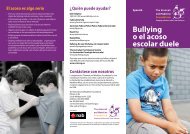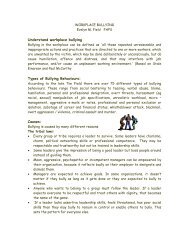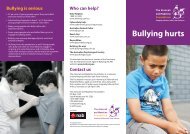The social and emotional wellbeing of students who bully different ...
The social and emotional wellbeing of students who bully different ...
The social and emotional wellbeing of students who bully different ...
Create successful ePaper yourself
Turn your PDF publications into a flip-book with our unique Google optimized e-Paper software.
SEWB are inclusive such that <strong>students</strong> at a higher level <strong>of</strong> SEWB are likely to display the positive <strong>social</strong><strong>and</strong> <strong>emotional</strong> characteristics <strong>of</strong> SEWB represented at lower levels.4. Students with lower levels <strong>of</strong> SEWB are likely to experience many negative emotions <strong>and</strong> behaviours(e.g. feeling down, stress, under-achievement, <strong>bully</strong>ing), as well as few positive emotions <strong>and</strong> behaviours(e.g. getting along with teachers, volunteering). <strong>The</strong>y are likely to demonstrate few <strong>social</strong> <strong>and</strong> <strong>emotional</strong>capabilities (low resilience, learning capabilities <strong>and</strong> <strong>social</strong> skills <strong>and</strong> values) as well as to perceive fewpositive actions <strong>of</strong> adults, peers <strong>and</strong> youth-oriented programs in their schools, homes <strong>and</strong> communities.Students with higher levels <strong>of</strong> SEWB are likely to experience fewer negative emotions <strong>and</strong> behaviours<strong>and</strong> a greater number <strong>of</strong> positive emotions <strong>and</strong> behaviours. <strong>The</strong>y are likely to demonstrate many <strong>social</strong><strong>and</strong> <strong>emotional</strong> capabilities as well as to perceive many positive actions <strong>of</strong> adults, peers <strong>and</strong> youth-orientedprograms in their schools, homes <strong>and</strong> communities.5. Students at all levels <strong>of</strong> SEWB do, however, demonstrate <strong>different</strong> childhood problems (<strong>bully</strong>ing,getting into trouble, feeling stressed, feeling down, under-achievement). Social <strong>and</strong> <strong>emotional</strong>characteristics that tend to accompany <strong>different</strong> childhood problems are reported. For example, <strong>students</strong><strong>who</strong> <strong>bully</strong> tend to have difficulty in thinking before they act when angry. Also approximately half <strong>of</strong> the<strong>students</strong> <strong>who</strong> <strong>bully</strong> have high self-esteem.6. Consistent differences are found in the ways that <strong>students</strong> view their <strong>social</strong> <strong>and</strong> <strong>emotional</strong>characteristics in comparison with the ways in which teachers perceive them. Teachers may be unaware<strong>of</strong> the extent <strong>of</strong> the <strong>emotional</strong> difficulties <strong>of</strong> <strong>students</strong> (anxiety, stress, anger), rating <strong>students</strong> as possessinglower levels while <strong>students</strong> say they possess higher levels. Additionally, in contrast with teacherperceptions, <strong>students</strong> with <strong>different</strong> childhood problems (<strong>bully</strong>ing, getting into trouble, stress, depressed,under-achievement) say they possess higher amounts <strong>of</strong> resilience (self-coping skills <strong>and</strong> rational attitudesfor regulating emotions <strong>and</strong> controlling behaviour), a positive <strong>social</strong> orientation (<strong>social</strong> skills <strong>and</strong> values),<strong>and</strong> a positive work orientation (learning capabilities–confidence, persistence, organisation, workcooperation).7. Rasch analyses indicate that <strong>different</strong> <strong>social</strong> <strong>and</strong> <strong>emotional</strong> characteristics correspond to <strong>different</strong>amounts <strong>of</strong> student SEWB. A set <strong>of</strong> <strong>social</strong> <strong>and</strong> <strong>emotional</strong> characteristics that contribute to higher levels <strong>of</strong>student <strong>social</strong> <strong>and</strong> <strong>emotional</strong> well-being has been identified (e.g. “Does not become easily distressedwhen he/she makes mistakes or when others are negative.” “Does not become easily frustrated <strong>and</strong> doesnot give up when attempting a new task he/she finds difficult.”).8. In both student <strong>and</strong> teacher surveys, girls display, in comparison with boys, significantly higher levels<strong>of</strong> SEWB. Significant gender differences were obtained on individual <strong>social</strong> <strong>and</strong> <strong>emotional</strong> characteristics(e.g. boys higher in getting into trouble a lot, not being able to st<strong>and</strong> following rules; girls higher inhelping classmates <strong>who</strong> seem unhappy, finding someone to talk with to calm down, organisation, havingfriends <strong>who</strong> try to do their best in schoolwork).9. According to the results obtained from teacher perceptions <strong>of</strong> <strong>students</strong>’ <strong>social</strong> <strong>and</strong> <strong>emotional</strong>characteristics, <strong>students</strong> from the highest 10% socio-economic level were rated significantly higher than<strong>students</strong> from the lowest 25% socio-economic level on a number <strong>of</strong> characteristics (e.g. raises h<strong>and</strong> toanswer a difficult question, does not require an adult present to calm down, participates in manyactivities, achieves to potential in schoolwork).10. <strong>The</strong> data clearly indicate that the <strong>social</strong> <strong>and</strong> <strong>emotional</strong> competence <strong>of</strong> <strong>students</strong> is a very importantcontributor to student SEWB with <strong>students</strong> at higher levels <strong>of</strong> SEWB displaying well-developed <strong>social</strong><strong>and</strong> <strong>emotional</strong> capabilities in three domains: resilience (coping skills <strong>and</strong> rational attitudes leading to selfmanagement<strong>of</strong> emotions <strong>and</strong> behaviours), positive <strong>social</strong> orientation (<strong>social</strong> skills <strong>and</strong> values leading topositive relationships <strong>and</strong> adaptive behaviour) <strong>and</strong> positive work orientation (learning capabilities4









